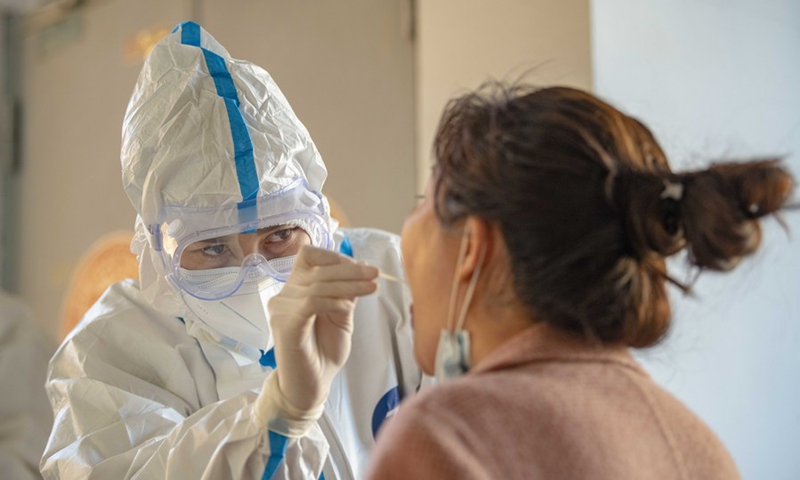Virus flareup in Xinjiang's Turpan likely related to imported blackcurrants from Central Asia
By Liu Caiyu Source: Global Times Published: 2020/12/15 18:57:23

A health worker takes a swab sample from a resident for COVID-19 test in Kashi, northwest China's Xinjiang Uygur Autonomous Region, Nov. 1, 2020. (Xinhua/Hu Huhu)
Turpan, an inland city in Northwest China's Xinjiang Uygur Autonomous Region, has become the latest city where coronavirus strains from the genotype of the European family were detected after previous outbreaks in Shanghai, Tianjin and Beijing. Experts warned that the highly infectious nature of these strains will require swifter and more timely efforts by local governments to detect and control any renewed outbreak.
The risks for cross-border goods and food causing domestic outbreaks are high, as an epidemic that occurred in Turpan demonstrated that the virus strains brought from overseas not only threaten port cities but also inland one through transportation, experts warned on Tuesday, stressing the importance of disinfecting imported goods.
Zhang Yuexin, a member of Xinjiang's anti-epidemic group, revealed to the Global Times on Tuesday that it is very likely that the asymptomatic patients in Turpan have some link to imported blackcurrants transported from a central Asian country via Alashankou port. The novel coronavirus was found on the outer packages of those imported blackcurrants.
Alashankou is the nearest railway port in China to the EU. Over 4,500 China-Europe freight trains have crossed the border through the inland port this year.
Full virus genetic sequencing of samples from Turpan showed that the virus from the latest outbreak belongs to the L genotype European family branch I/B.1.1 evolutionary branch, and it shares no similarities with the previous virus variants discovered in Kashi, Urumqi or other Chinese cities, authorities from Xinjiang also said on Monday.
Turpan, a non-port city in Xinjiang, reported four asymptomatic cases in one day over the weekend, but no more new infections were found during widespread free nucleic acid testing carried out in Turpan since then.
Among the four patients, three work at a local fruit processing plant in Turpan. The chance of imported blackcurrants causing the outbreak is high, Zhang said, noting that a conclusion cannot be reached immediately as the information is being verified by the authorities.
Zhang revealed that the imported blackcurrants may not have been thoroughly disinfected before being transported from overseas.
It is a reminder for Chinese cities, especially for border cities, that overseas strains of the virus can easily cross the border and cause local infections if cities cannot thoroughly detect and disinfect the virus, either on containers, foods or outer packaging, experts noted.
Since June, several regions in China have detected coronavirus on imported cold-chain food or its packaging, prompting many across the country to implement strict quarantine measures, such as the setting up of centralized disinfection warehouses.
Outbreaks in Shanghai, Tianjin, Beijing and now Turpan, which are all linked to the L genotype of European families, demonstrate the highly infectious nature of this genotype, Yang Zhanqiu, a senior virologist at Wuhan University, told the Global Times on Tuesday. Thus, local governments need to act more swiftly in tracking close contacts and identifying the source of infections, Yang said.
Wu Zunyou, the chief epidemiologist of the Chinese Center for Disease Control and Prevention, said in June that having the genotype of European families doesn't mean the virus comes from European nations directly but from regions where this type of virus is prevalent.
Media reported that the strain that caused the outbreak in Beijing's Xinfadi is the European branch I of the L genotype. The COVID-19 strain taken from samples of the confirmed case found in Tianjin shares a high similarity with the virus strain that was prevalent in North America from March to June, and it belongs to the L type found in Europe.
Virus genotypes of six cases related to Shanghai's Pudong airport belong to the L genotype of a branch of European Ⅱ. 1. The sources of infection are related to overseas aircraft environment or personnel.
RELATED ARTICLES:
- Beijing reports one imported case from Hong Kong after patient was discharged from 14-day quarantine
- Virus in Xinjiang's Turpan outbreak belongs to evolutionary subtype of L genotype of European family
- GT investigates: COVID-19 battle: beyond competition between two systems
- China's vaccine trip abroad
Posted in: SOCIETY